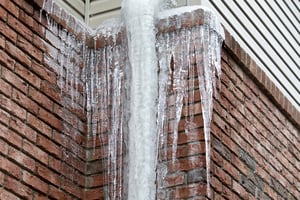 Buying a home is probably the biggest purchase you’ll make. Your home is also the place where you’ll make the most memories. But the work doesn't stop after the paperwork is completed and you’re moved in. Owning a home requires monitoring and periodic maintenance. Storms and other weather conditions can strain your home and cause damage.
Buying a home is probably the biggest purchase you’ll make. Your home is also the place where you’ll make the most memories. But the work doesn't stop after the paperwork is completed and you’re moved in. Owning a home requires monitoring and periodic maintenance. Storms and other weather conditions can strain your home and cause damage.
Here are some things to watch out for this winter:
1. Frozen pipes.
Extreme cold temperatures can cause your pipes to freeze. Luckily, there are some warning signs to watch for. Be sure you’re familiar with where your shutoff valves are in your home. And never set your thermostat too low.
2. Roof damage.
Several things could damage your roof this winter. High winds can loosen shingles and send them flying. The weight of snow and ice could cause the roof to collapse. Lastly, ice dams can cause water to penetrate your home. Going on your roof can be dangerous at any time of the year. It’s especially true during the winter months. However, keeping an eye on the roof from the ground can help prevent serious damage from occurring.
3. Concrete damage.
It’s important to keep your sidewalks and driveway clear of ice and snow to prevent slips and falls. Unfortunately, shoveling, picking away at ice, and using de-icing products can cause damage, such as chips and cracks. If shoveling becomes overwhelming, consider calling a professional for help.
4. Deck damage.
Like your roof, the weight of snow and ice can cause damage to your deck. If snow begins to build up, removing it’s a good idea. However, don’t use a metal shovel or plastic shovel with a metal edge because they can damage the wood. If that’s all you have, remove the snow in layers and use a soft-bristled push broom or leaf blower to remove the rest.
5. Cracked caulk.
If you feel a draft in your home, check around your windows. Cold temperatures can cause the caulk to crack. During the last several winters, I’ve had to apply additional caulk around a few of my windows. It’s an easy fix that can keep your home warmer this winter.
6. Gaps in hardwood floor or other trim.
Gaps in your wood doesn’t necessarily mean damage occurred. It means that your home is extremely dry. Humidity levels in your home during the winter months should be between 30 and 50 percent. There are many benefits to achieving this humidity level.
7. Broken tree limbs.
High winds and the weight of ice and snow can damage your trees. Unfortunately, there’s not much you can do to protect them. However, your homeowners insurance policy may provide coverage for them. Talk to your agent to learn more. If the trees are too big, call a professional service to have them removed. If your home is damaged, make sure you report it to your insurance company right away. Depending on the damage, a restoration company may be needed.
8. Fire damage.
Nearly half of all home heating fires occur in December, January, and February. And if you have an old electrical system, space heaters may tax their capacity. Here are some heating safety tips to prevent your home from catching fire this winter.Being proactive is the best way to prevent damage to your home. Do your research and figure out how you can protect your home from Mother Nature.
Do you have any information or suggestions you’d like to share? I’d love to hear from you. Please share them in the box below.





